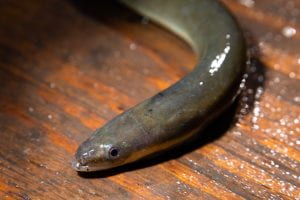Over 150 species of fishes are represented in the Hudson River Biological Monitoring Program. Below is a highlight of five species of interest which have been well surveyed.
American eel (Anguilla rostrata)
American eels spend more of their lives living in freshwater and brackish tributaries of estuaries along the East Coast of the United States, such as the Hudson River Estuary. They are catadromous, meaning adults leave estuaries and spawn in the ocean. Later, their young swim back into freshwater systems. As mature eels, they leave the estuary in the fall, typically October, and make their way to the Sargasso Sea, an area of the Atlantic Ocean east of the Bahamas. In January, American eels spawn and then die, leaving the newly hatched eels to float and grow in the Atlantic Ocean for about one year. Ocean currents move them along the coast before making their way into estuaries. At this stage they are commonly called glass eels because they are clear. As they swim upstream, they start to develop color and turn brown. These eels are only a few inches in length and are typically called elvers.
Diet: Adults eat primarily worms, small fish, and mollusks.
Predators: Larger fish and fish eating birds like eagles, ospreys, and gulls.
Size: Males will reach about 2 feet in length and females about 3 to 5.
Life Span: 5 years but can live up to 20.
Atlantic sturgeon (Acipenser oxyrinchus oxyrinchus)
Atlantic sturgeon are anadromous fish, meaning they spend most of their lives in the ocean and return to estuaries to spawn. Adults return to rivers to spawn every 3 to 5 years during the spring. In one spawning season, females can lay up to 2 million sticky black eggs on the river bottom. Once hatched Atlantic sturgeon remain in their natal river for up to 6 years before swimming into the estuary and then finally the Atlantic Ocean. Males can take up to 10 years to mature and females up to 20. Instead of scales, Atlantic sturgeon have a series of bony plates called scutes, and there is one on each side of the body, one on the back, and two on the belly.
Diet: Sturgeon are bottom feeders eating primarily crustaceans, mollusks, insects, and worms.
Predators: Sturgeon have few predators because of their bony plates, but their population has suffered from human impacts, including overfishing and habitat damage from pollution and damming.
Size: 5 to 6 feet in length. Males typically reach 90 pounds and females 160.
Life Span: More than 60 years.
Atlantic Tomcod (Microgadus tomcod)
Atlantic tomcod or frost fish are a small anadromous fish that range along the Atlantic coast from Labrador to the Chesapeake Bay. Adults live in the mouths of estuaries and begin moving, starting in October and November, from the mouth of the estuary into low saline or even fresh water to spawn in January into February. Eggs are laid on pebble covered bottoms, and hatch within 24 to 30 days. Newly hatched larvae float to the surface and breathe air until their pneumatic duct closes. Since they do not leave estuaries completely, Atlantic tomcod are more prone to being exposed to freezing conditions. Atlantic tomcod have developed the ability to produce antifreeze proteins making them very tolerant of cold water temperatures.
Diet: Larvae eat copepods. Adults eat mostly small crustaceans, shellfish, worms, juvenile fish, and fish eggs including their own.
Predators: Striped Bass and Blue fish.
Size: 9 to 12 inches in length.
Life Span: Up to 4 years.
Striped Bass (Morone saxatilis)
Striped bass are a large predatory fish found along the entire East Coast of the United States, but mainly from Maine to North Carolina. They are also anadromous fish with adults spending most of their life in the Atlantic Ocean and mouths of estuaries and returning to natal rivers each spring to spawn. The largest spawning population is found in the Chesapeake Bay, with an estimated 80% of the total population, but there are a significant number that return to the Hudson River each spring. Males typically take 2 years to reach maturity and females 4. Female fecundity is related to their size, with larger females producing more eggs. Striped bass larvae develop and make their way downstream in the river eating plankton. They mature into juveniles in nursery grounds within estuaries and river deltas and remain there for 2 to 4 years. After that time, the mature fish enter the Atlantic Ocean moving north during the summer and south in the winter with a large number of adults remaining offshore.
Diet: Striped bass are opportunist feeders, but mainly eat Bunker, also known as Menhaden, squid, Sand eels, Butterfish, and other smaller fish.
Predators: Larger fish, sharks, and birds of prey like osprey.
Size: 2 to 3 feet in length but can reach up to 6 feet and 125 pounds.
Life Span: 10 to 30 years.
White Perch (Morone americana)
White perch live mainly in brackish waters, such as the Hudson River Estuary. During the warmer months, White perch spend time in shallower water and move to deeper water in the winter months. They are found throughout estuaries along the Atlantic coast. White perch are not a true perch but are actually members of the bass family. Adults spawn in the late spring, laying sticky eggs on aquatic vegetation or on the bottom. While these fish are native to brackish water, they have invaded the Great Lakes region and become invasive.
Diet: Adults eat small fish, insects, detritus, fish eggs and larval fish. Juveniles feed on tiny zooplankton, including insects and crustaceans.
Predators: Blue fish, Weakfish and Striped bass.
Size: 7 to 10 inches in length and rarely more than 1 pound.
Life Span: Up to 17 years.
